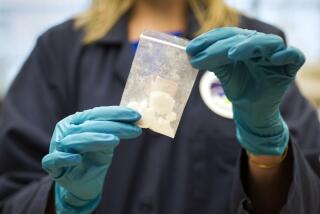Agencies Pursue Massive Probe of Tylenol Poisoning
- Share via
NEW YORK — Government agencies at all levels pressed a massive investigation Friday into poisoned Tylenol. The FBI pored over the employment records of the drug’s manufacturer, chemists analyzed more than 200,000 Tylenol capsules and law enforcement officials summoned members of the team still searching for those responsible for Chicago’s Tylenol killings in 1982.
The federal Food and Drug Administration announced that cyanide found in a second bottle Thursday was “chemically identical” to that used to kill Diane Elsroth last week, leading authorities to conclude the poison probably came from the same source.
FBI laboratory technicians examined the second bottle, trying to determine whether its tamper resistant seals were forged or opened and re-glued.
Johnson & Johnson, Tylenol’s manufacturer, said there were no obvious signs the plastic bottle had been penetrated. Scientists found no holes, cuts or needle marks.
“The indication was that it was the original factory seal at all three points,” said James E. Burke, the drug company’s chairman. “If this was done, it was done by somebody very, very bright who has the technology.
“This is an act of terrorism, pure and simple,” he added. The company offered a $100,000 reward for information leading to the arrest and conviction of the poisoner.
Burke was asked at a news conference at the company’s headquarters in New Brunswick, N.J., if he thought an employee or former worker was responsible. “We honestly don’t know that’s the case at all,” he said. “This investigation is going to be absolutely massive at all levels. All employee records are being examined.”
Throughout the day, officials of the FDA, FBI and Johnson & Johnson conferred frequently. Tylenol’s manufacturer provided investigators with employee records and other data. FDA laboratories joined with company chemists in taking apart and analyzing 200,000 capsules, all taken from the area around Yonkers, N.Y.
Police in the New York City suburb of Westchester County said they had no suspects and discounted an extortion letter claiming responsibility for the poisoning and demanding $2 million be paid to prevent the poisoning of other products. The man who claimed he wrote the note was charged only with credit card fraud in another case.
“I think it’s just one of those trying to extort money and trying to get publicity,” said Bronxville Police Chief Carl Steinmuller.
But as the mystery of how the capsules were poisoned deepened, nine other states joined New York in banning the sale of Extra-Strength Tylenol capsules. In New York City, police officers were sent into drugstores, supermarkets and shops to be sure Tylenol capsules were taken off shelves. Non-capsule forms of Tylenol were not removed.
Johnson & Johnson and the FBI picked up all Tylenol capsules within a three mile radius of the locations in Westchester County where the poisoned pills were purchased.
Stenographer’s Death
Elsroth, a 23-year-old stenographer, died Saturday after taking two Extra-Strength Tylenol capsules at the home of her boyfriend in Yonkers, N.Y. Authorities said the bottle had been freshly opened at home. It was purchased at an A&P; supermarket in nearby Bronxville, N.Y. Three other poisoned capsules were later found in the bottle.
On Thursday, scientists discovered five other poisoned Tylenol capsules in another bottle taken from a Woolworth’s store about two blocks from the A&P.; FBI laboratory technicians scrutinized both bottles for fingerprints.
FDA Commissioner Dr. Frank Young said Friday the agency’s laboratory in Cincinnati had analyzed the cyanide in the second bottle and concluded the poison in both bottles stemmed from the same source.
“The cyanide in this second bottle of Tylenol Extra Strength capsules is chemically identical to the potassium cyanide implicated in the death of Diane Elsroth,” the FDA commissioner added. “Therefore, both samples must have come from the same source.”
Young said the Bronxville cyanide did not match cyanide found in the Chicago area in 1982, when seven people were killed.
Separate Batch Numbers
The two 24-capsule bottles containing the Bronxville poison had separate batch numbers. One bottle bore the identification ADF916, expiring in May, 1987. It was manufactured in Fort Washington, Pa. The other bottle, AHA090, expiring in April, 1987, was manufactured in Puerto Rico.
FBI agents and Johnson & Johnson executives tried to determine whether the two bottles were ever stored in the same place during their route to store shelves. Investigators also were trying to determine if the second bottle of Tylenol could have been produced in Pennsylvania even though it carried the Puerto Rican lot number.
Burke said it was possible both bottles had been at a common distribution point at different times.
“You had two bottles produced at two separate places at two separate times,” Johnson & Johnson’s chairman said. “What are the chances of them going through the distribution system and ending up in the same city a block apart? We still believe it’s local tampering, but we can’t prove it didn’t happen at the plant. Once we had a second event, it lends greater credence it didn’t happen in the plant.”
Johnson & Johnson manufactures Tylenol with three seals. Warnings against taking the medicine from damaged packages are prominently displayed. The box containing the bottle is glued shut. A plastic band seals the cap to the neck of the bottle. The bottle’s mouth is protected by a tough foil membrane.
Penetration Study
Investigators had said earlier that the cyanide would have eaten through the gelatin capsules in 10 days or less, but the FDA said Friday that the cyanide could have been contained in capsules longer than that. Deputy FDA Commissioner John Norris said the cyanide was being studied to determine its capsule penetration time.
When poisoned Tylenol was discovered in Chicago, the investigation was so unprecedented it took days before effective mechanisms were set up to screen capsules. Officers ran down more than 2,000 leads. They even scrutinized people who had engaged in unusual trading in Johnson & Johnson stock prior to the contamination. More than 60 volumes of information were compiled.
Sources close to the Illinois investigation have said that they believe they know who was responsible for the Tylenol deaths in the Chicago area. But they say they haven’t been able to amass enough evidence to bring charges. Two men are in prison for related crimes, but neither has been charged with the killings.
John J. Goldman reported from New York and Marlene Cimons from Washington. Also contributing were Times staff writers Larry Green and Scott Kraft in Chicago and researchers Tony Robinson and Siobhan Flynn in New York.
More to Read
Sign up for Essential California
The most important California stories and recommendations in your inbox every morning.
You may occasionally receive promotional content from the Los Angeles Times.













